P
Pabst, Guido Frederico Joao (1914—1980) Dynamic Brazilian orchidologist whose many publications include the comprehensive Orchidaceae Brasiliensis with F. Dungs. Pabstia (PABST-ee-a)The five epiphytic species in this genus are native to tropical Brazil. Garay removed them from Colax in 1973, naming the new genus in honor of Guido Pabst, co-author of Orchidaceae Brasiliensis. pachyphyllus, -a, -um (pak-ee-FILL-us) Thick-leaved. pallens (PAL-lenz) Becoming pale or light in color. pallidus, -a, -um (PAL-li-dus) Pale, pallid. palmatus, -a, -um (pal-MAY-tus) Lobed and radiating like the fingers; palmate. paludosus, -a, -um (pal-yew-DOH-sus) Growing in marshes; paludose. Palumbina (pal-um-BEE-na) A monotypic epiphytic genus from Guatemala. H.G. Reichenbach described the genus in 1863, deriving the generic name from the Greek word "belonging to a dove," probably a reference to the white flowers, as white is associated with doves. The single species is now correctly, Cuitlauzina candida. palustris, -e (pal-US-triss) Growing in marshes; palustrine. pan A form of pot that is broader and shallower than the regular type. These are also known as azalea pots or bulb pans.
pandurata: Coelogyne pandurata has a lip shaped like a fiddle.
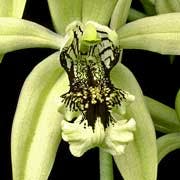
panduratus, -a, -um (pan-dew-RAY-tus) Shaped like a fiddle; pandurate.
panduriformis, -e (pan-dew-ri-FOR-miss) Fiddle-shaped; panduriform.
panicle (PAN-i-kul) A loosely arranged branched inflorescence, blooming from the center or lower branches to the outer ends or top.
paniculate (pan-IK-yew-layt) Having an inflorescence resembling a panicle.
paniculatus, -a, -um (pan-ik-yew-LAY-tus) With flowers arranged in a paniculate manner.
Panisea (pan-EE-see-a) The seven species in this genus may be either epiphytic or lithophytic and come from Southeast Asia, mainly Nepal and India. Lund founded the genus in 1987 by removing these species from Coelogyne. He derived the generic name from two Greek words meaning "all" and "equal" due to the similarity between the sepals and petals.
pannose (pan-noze) Having the texture of felt or woven cloth.
Pantling, Robert (1856—1910) British botanist, co-author, with George King, of the monumental The Orchids of the Sikkim-Himalaya (1898).
Paphinia (paff-EE-nee-a) The five epiphytic species in this genus range from Guatemala south to northern South America. Lindley described the genus in 1843, using the Cypriot name for Aphrodite as the generic name.
Paphiopedilum (paff-ee-oh-PED-i-lum) A genus of about 60 species of the lady's-slipper orchids from the Asiatic tropics, formerly included in the genus Cypripedium, the name having been proposed by Pfitzer in 1886 in allusion to the slipper-shaped lip.
papilio: The flowers of Psychopsis papilio var. alba resemble a butterfly.
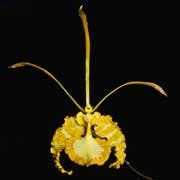
papilio (pa-PILL-ee-oh) A butterfly.
Papilionanthe (pap-ill-ee-oh-NAN-thee) A genus of 10 species of Asian orchids formerly included in Vanda and known in horticulture as terete-leaved vandas, commonly grown landscape plants in the tropics and the usual flower of orchid leis.
papillae (pa-PILL-ee) Minute nipplelike projections.
papillosus, -a, -um (pap-ill-OH-sus) Covered with nipple-like protuberances on the surface; papillose.
paraphalaenopsis: Paraphalaenopsis labukensis is one of four species in the genus.
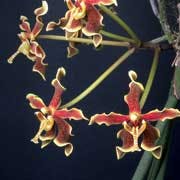
Paraphalaenopsis (pair-ah-fayl-e-NOP-sis) A genus of four species of vandaceous orchids endemic to Borneo, characterized by terete leaves and subumbellate inflorescences, named for the flowers' similar morphology to Phalaenopsis.
paraphyletic (pair-ah-fy-LET-ick) Cladistic term for a group that does not include all descendants of a common ancestor.
parasite A plant that grows on and derives part or all of its nourishment from another plant, called the host.
pardinus, -a, -um (par-DYE-nus) Spotted like a leopard or panther.
parenchyma (puh-RENG-kuh-muh) Said of undifferentiated cells with thickened walls.
parent (pare-ent) One of the two particular plants responsible for the production or generation of a given plant or progeny.
parietal (pa-RYE-e-tal) Borne on the inner surface or wall surface of a capsule or ovary.
Parish, Charles Samuel Pollock (1822—1897) An English missionary, stationed at Moulmein, Burma, he collected, illustrated and introduced from that country many fine orchids, such as Paphiopedilum parishii.
parted (par-ted) Cleft or cut almost to the base.
parthenogenesis (par-thin-oh-JEN-e-siss) The process by which a seed may develop without fertilization; plants so produced have the genetic constitution of the seed-bearing plant.
partitus, -a, -um (par-TYE-tus) Divided nearly to the base; partite.
partitioned (par-TISH-und) Divided in compartments or chambers by internal horizontal walls.
parviflorus, -a, -um (par-vi-FLOR-us) Small-flowered.
parvus, -a, -um (PAR-vus) Small.
passerinus, -a, -um (pass-er-EYE-nus) Resembling or marked like a sparrow; passerine.
patelliform (pah-TELL-ih-form) In the shape of a disc.
patens (PAY-tenz) Spreading.
patent (PA-tent) Expanded or spreading.
pathogen (PATH-oh-jen) A disease-producing organism.
pathological (path-oh-LOJ-i-kul) Diseased.
pathology (path-OLL-oh-jee) The science dealing with diseases, their causes, results and cures.
patulus, -a, -um (PAT-yew-lus) Spreading, broad, flat; patulous.
paucus, -a, -um (PAW-kus) Few. In compound words pauci-.
Paxton, Sir Joseph (1801—1865) British gardener-orchidist who superintended the orchid collection and grounds of the 6th Duke of Devonshire at Chatsworth. He introduced Paxton's Magazine of Botany (1834) and was a founder of Gardener's Chronicle. He invented and introduced inexpensive greenhouses for the general populace and designed the Crystal Palace, a domed conservatory greenhouse, for England's first Great Exhibition.
peat (peet) Any mass of semicarbonized vegetable tissue formed by a partial decomposition in water of various plants, especially species of the moss genus Sphagnum.
Pecteilis (peck-TILE-iss) An East Asian segregate of Habenaria, the nine species of which are prized for their cranelike white flowers with spectacularly fringed labella. Rafinesque described the genus in 1836, deriving the generic name from the Greek work meaning "pectin" to describe the pectinate side lobes of the lip.
pectinatus, -a, -um (pek-ti-NAY-tus) Shaped like a comb, with narrow parallel projections; pectinate.
pedalis, -e (ped-AY-lis) About one foot long.
pedatus, -a, -um (ped-AY-tus) Like a bird's foot; footlike; pedate.
pedicel: Cattleya longipes showing the pedicels.

pedicel (PED-i-sel) The ultimate division of a common peduncle; the stalk of an individual flower; in orchids usually continuous with the inferior ovary.
pedicellate ovary (PED-i-sel-layt OH-va-ree) In orchids, the combined pedicel with the ovary of the flower.
peduncle (pe-DUNK-ul) Stalk of a flower-cluster or of a flower. The stalk of an inflorescence that bears the pedicels and flowers.
peduncularis, -e (pe-dunk-yew-LAY-riss) Having long peduncles or peduncular flower-stalks.
pedunculatus, -a,-um (pe-dunk-yew-LAY-tus) Borne on a peduncle; pedunculate.
Pelatantheria (pell-at-an-THEER-ee-a) There are five epiphytic species in this genus native from Southern China south to Indonesia. Ridley named the genus in 1896, using the Greek words "approaching or neighbor" and "anther" but the meaning is not clear.
Pelexia (pell-EKS-ee-a) This genus consists of about 50 terrestrial species from temperate and tropical South America, being most common in Brazil. Richard described the genus in 1818, using the Greek word meaning "helmet" to denote the structure of the sepals.
pellicle (PELL-i-kuhl) An epidermis or surface membrane.
pellucid (pel-LOO-sid) Clear or transparent.
peloria: Cattleya intermedia (Aquinii) exhibits peloria.
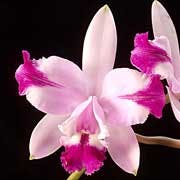
peloria (pe-LOR-ee-a) Abnormal regularity of structure occurring in flowers normally irregular; generally applied to orchids where the petals have lip characters or colors. Also when lips take on petal characteristics.
peltatus, -a, -um (pel-TAY-tus) Shield-shaped; peltate.
pendulus, -a, -um (PEN-dew-luss) Hanging or drooping; pendulous.
pennatus, -a, -um (pen-AY-tus) Feathered.
pentadactylus, -a, -um (pen-tah-DAK-til-us) Five-fingered; pentadactyl; pentadactylate.
pentamerous (pen-TAM-er-us) Consisting of or divided into five parts.
pentaploid (PEN-ta-ployd) Having five sets of chromosomes (5N).
pentas (pen-tus) Greek prefix meaning five.
perbellus, -a, -um (per-BELL-us) Very beautiful.
percussus, -a, -um (per-KUSS-us) Perforated, or appearing so.
perennial (per-ENN-ee-al) Having a life cycle lasting more than two years.
perfect (PER-fekt) Said of flowers that have both the staminate (male) and pistillate (female) parts.
perfoliate (per-FOLL-ee-ayt) Said of stems that pass through a leaf.
pergameneous (per-gah-MEN-ee-us) Having the texture of parchment.
peri- (PARE-ee) A prefix derived from the Greek, signifying "around," "about," "beyond" in scientific terms.
perianth (PARE-ee-anth) The floral envelope considered as a whole, consisting of the calyx (sepals) and corolla (petals), whatever their form.
pericarp (PARE-ee-karp) The outer ovary wall.
peripheral (puh-RIF-er-uhl) Near the edge or margin
Peristeria (per-is-TER-ee-ah) A small genus of 15 species of epiphytic orchids from Panama and northern South America. Related to Lycomormium, it was described by Hooker in 1831, the name meaning "little dove" from the resemblance of the column and lip to a dove. Peristeria elata, the national flower of Panama, is popularly called the "dove orchid."
perlite (purr-LITE) A lightweight, heat-expanded phosphate rock used to add aeration to potting media.
persistent (puhr-siss-tent) Remaining for a long time, as leaves or flowers on the plant.
pertusus, -a, -um (per-TEW-sus) Perforated; having an aperture.
peruvianus, -a, -um (per-ROO-vee-ay-nus) Native of Peru; Peruvian.
Pescatorea (pess-ka-TOR-ee-ah) A small genus of 16 species of pseudobulbless epiphytic orchids distributed from Costa Rica to Ecuador. It is related to Bollea and Huntleya. Described in 1852 by Reichenbach, it was dedicated to M. Pescatore, a French orchid enthusiast.
pesticide (PESS-ti-cyde) General term for any chemical used to kill or control pests (e.g., fungicide, insecticide, herbicide)
petal (PET-al) One of the segments of the corolla of a flower; in orchids, one of the three petals is usually modified into a lip or labellum.
petaloid (PET-a-loyd) Resembling a petal.
Peterson, Richard (1940—1984) Former Editor of the American Orchid Society Bulletin (1973—1984), credited with changing the journal to an all-color publication, and a former Executive Director of the Society (1977—1984)
petiolatus, -a, -um (pet-ee-oh-LAY-tus) Having a petiole; petiolate.
petiole (PET-ee-ohl) The stalk by which a leaf is attached to a stem.
Pfitzer, Ernst Hugo Heinrich (1846—1906) German orchidologist, Professor of Botany and Director of the Botanical Garden at the University of Heidelberg, he contributed much to modern phylogeny of the orchids, including the orchid family in Engler and Prantl's Die Naturlichen Pflanzenfamilien and the monograph of the Cypripedium tribe in Das Pflanzenreich.
pH (PEE-ACHE) The chemical symbol representing the negative log of the hydrogen ion concentration as an indicator of acidity of a solution, pH 7.0 being neutral, acidity under 7.0 and alkalinity over 7.0.
Phaius (FAY-us) A genus of 45 species of terrestrial orchids widely distributed in Indo-Malaysia and China from India to New Guinea, related to Calanthe and Spathoglottis, it was described by Loureiro in 1790, the name referring to the swarthy colors of the flowers.
Phalaenopsis (fail-eh-NOP-siss) A genus of 50 species of showy epiphytic orchids from the Asiatic tropics, related to Doritis and Sarcochilus, it was founded by Blume in 1825, the name referring to the mothlike appearance of the flower.
phenogam, phenerogam (FEE-noh-gam) (FEE-ner-oh-gam) Flowering plants; seed-bearing plants (as distinguished from spore-bearing, or cryptogams)
phenotype (FEE-noh-type) The extrnal expression of a genotype.
philippinensis (fill-ip-pin-EN-sis) Native of the Philippines; Philippine.
phloem (FLOH-em) The food conducting tissue within the vascular system of the plant.
phoenicius, -a, -um (fee-NISH-us) Purple-red.
Pholidota (fol-i-DOH-tah) A medium-sized genus of pseudobulbous epiphytes from India and southern China to Australia, related to Dendrochilum and Coelogyne, it was established in 1825 by Lindley, the name arising from the presence of scaly bracts on the inflorescence, hence the common name of "rattlesnake orchid."
photoperiodism (foh-toh-PEER-ee-oh-dizm) The response of a plant to the daily duration of daylight, correlated to seasonal changes.
photosynthesis (foh-toh-SIN-the-siss) The formation of carbohydrates, in constructive metabolism, from water and the carbon dioxide of the air in the chlorophyll-containing tissues of plants exposed to light.
Phragmipedium (frag-mi-PEE-dee-um) A small genus of 26 species of lady's-slipper orchids distributed from Mexico to Peru, and established by Rolfe in 1896; related to Cypripedium, plants of this genus were incorrectly called Selenipedium in cultivation.
Phreatia (FREET-ee-a) This widespread genus of about 150 epiphytic species ranges from India east to the Pacific Islands and south to Australia. Lindley described the genus in 1830, deriving the generic name from the Greek word meaning "well" to denote the well-like mentum formed by the sepals and lip.
phyllodium ( phyllodia) (FILL-oh-dee-um, FILL-oh-dee-a) A dilated petiole that resembles a leaf.
phyllotaxy (FILL-oh-tak-see) The arrangement of leaves on the stem.
phylogenetic (fye-loh-je-NET-ik) Pertaining to the evolutionary history of a type or group of organisms; the evolutionary system of a type or group of organisms.
phylogeny (fye-LOJ-en-ee) Evolutionary history of a group of organisms.
phyllum (FILL-um) In compound words meaning leaf, as in aphyllum meaning "without leaves."
phylum (FYE-lum) A primary division of the animal or vegetable kingdom.
Phymatidium (fye-mah-TID-ee-um) The dozen or so epiphytic species in this genus come from South America. Lindley established the genus in 1833, using the diminutive of the Greek word for "growth" to denote the small size of these plants.
phymatochilus, -a, -um (fye-mat-oh-KYE-lus) Having a swelling on the lip.
Physosiphon (fye-so-SIGH-fon) A genus of about six species of tufted epiphytic orchids from the American Tropics. Related to Pleurothallis and frequently considered a synonym, it was founded by Lindley in 1836, the name referring to the tubelike base of the connate sepals.
phytology (fye-TOL-oh-jee) The study of plants; particularly of the kinds or species; botany.
phytotoxicity (fye-toh-tok-SISS-i-tee) Poisonousness to plants.
picturatus, -a, -um (pik-tew-RAY-tus) Variegated.
picta: The flowers of Maxillaria picta have a painted appearance.

pictus, -a, -um (PIK-tus) Painted.
pileatus, -a, -um (pil-ee-AY-tus) Furnished with a cap.
pilosus, -a, -um (pye-LOH-sus) Covered with long soft hairs; pilose.
pinnatus, -a, -um (pin-NAY-tus) Featherlike, having leaflets arranged on each side of a common stalk; pinnate.
pisiform (PYE-sih-form) Pea shaped
pistil (PISS-til) The seed-bearing organ of the flower, consisting of the ovary, stigma and, when present, style.
pistillate (PISS-til-layt) Having pistils and no stamens; female.
pitted (pih-TED) Marked with small depressions or pits.
placatus, -a, -um (pla-KAY-tus) Quiet; calm; placid.
placenta (pla-SEN-ta) That part or place in the ovary where ovules are attached.
plaited (PLA-ted) Folded lengthwise, as a closed fan; pleated; plicate.
planus, -a,-um (PLAY-nus) Flat; plane.
plastid (PLAS-tid) A class of cellular organelles that contains either pigments (chloroplast, chromoplast) or starch (amyloplast)
Platanthera (plah-TAN-ther-ah) A genus of 40 species of North Temperate orchids formerly included in a broadly defined Habenaria, commonly known as the fringed orchids. Louis-Claude-Marie Richard founded the genus in 1818, deriving the generic name from two Greek words meaning "broad" and "anther," a reference to the broad anthers found in this genus.
Platystele (plat-ee-STEE-lee) There are some six epiphytic species in this genus distributed in Central and South America. Schlechter described the genus in 1910, deriving the generic name from two Greek words meaning "broad" and "column" to denote the short column.
plaque (plack) A vertical growing substrate of cork, tree fern, wood or other material. (See slab)
platy- (PLAT-ee) In Greek combinations, signifying "broad," "wide" or "flat."
Pleione (plye-OH-nee) A genus of 15 species of diminutive pseudobulbous orchids from the Himalayas and Southeast Asia. Related to Coelogyne, it was established in 1825 by D. Don, who dedicated it to Pleione, mother of the Pleiades in Greek mythology.
plenus, -a, -um (PLEE-nus) Double or full.
plesiomorphy (PLEE-zee-oh-more-fee) A cladistic term referring to an ancestral character state.
Pleurothallis (plur-oh-THAL-liss) A genus of 1,120 species of chiefly epiphytic pseudobulbous orchids from the American tropics. Related to Masdevallia and Stelis, it was established in 1813 by Robert Brown, the name referring to the riblike leaf stalks found in most species.
plicatilis, -e (plye-kayt-EYE-liss) Folded; plicate.
plicatus, -a, -um (plye-KAY-tus) Folded like a fan, or pleated; plicate.
Plocoglottis (plo-ko-GLOTT-iss) The 40 terrestrial species in this genus range from the Andaman Islands east to Indochina and south to New Guinea. Blume described the genus in 1825, deriving the generic name from two Greek words meaning "binding together" and "tongue," a reference to the attachment of the lip to the column.
ploidy, or —ploidy (PLOY-dee) The number of sets of chromosomes in a cell.
plumosus, -a, -um (ploo-MOH-sus) Feathery; featherlike; plumose.
pod (pod) Horticultural (but botanically incorrect) term for the seed capsule of an orchid.
Pogonia (poh-GOH-nee-ah) A genus of two terrestrial species widely distributed in the North Temperate Zone in both hemispheres, it was founded by Jussieu in 1789, the name referring to the bearded crest on the lip of most species.
pollen (POL-len) The fertilizing grains contained in the anther.
pollinarium (pol-li-NAIR-ee-um) The inclusive term for the pollination unit of most orchids, comprising pollinia and caudicles, viscidium, or viscidium and stipe.
pollination (pol-li-NAY-shun) The application of pollen to the receptive surface of the stigma.
pollination biology (pol-li-NAY-shun bye-ol-OH-gee) The study of the interaction between floral morphology and pollinator behavior.
pollinia: Orchid pollinia stuck to the back of a bee.

pollinia (sing. pollinium) (pol-LIN-ee-a) The masses of waxy pollen or of coherent pollen grains found in the anthers of most orchids.
Podangis (poe-DAN-gis) A monotypic epiphytic genus from Central and Western Africa. Schlechter identified the genus in 1918, using two Greek words meaning "foot" and "vessel" to describe the footlike spur on the lip.
polliniferous (pol-li-ni-FER-us) Having pollen.
poly-(POL-ee) In Greek combinations, signifying "numerous" or "many."
polyanthus, -a, -um (pol-ee-AN-thus) Many-flowered.
polybulbon (pol-ee-BUL-bon) Having many bulbs.
Polycycnis (pol-ee-SIK-niss) A genus of 16 species of epiphytic orchids distributed from Costa Rica to Peru and related to Gongora. It was described by Reichenbach in 1855, the name literally meaning "many swan," in reference to the fancied resemblance of the many flowers to swans.
polyethylene (pol-ee-ETH-i-leen) A nearly transparent plastic which, in sheet form, is used as a temporary greenhouse covering or as inside insulation.
polyembryony (pol-ee-em-BREE-on-nee) Having more than one embryo in an ovule.
polygamous (pol-IG-ah-mus) Having unisexual and hermaphrodite flowers on the same or on different plants of the same species.
polymin (POL-e-min) A term applied to hybrids between polyploid and miniature Cymbidium.
polymorphic (pol-ee-MOR-fik) Having or assuming several distinct forms.
polyphyletic (pol-ee-FIH-let-ik) An artificial taxon in classification that has two or more ancestral groups.
polyploid (POL-ee-ployd) Having more than two chromosome sets in each somatic cell, or an organism with this condition.
Polyradicion (pol-ee-rah-DIS-ee-on) A genus of five species of leafless epiphytic orchids found in the tropics and subtropics of South Florida and the Caribbean area, it is related to Dendrophylax and Campylocentrum; it was described by Pfitzer as Polyrrhiza in 1889, the name referring to the many conspicuous roots. In 2002, P.M. Brown moved these species into the genus Dendrophylax.
Polystachya: Polystachya concreta is a common lowland orchid of the American tropics.
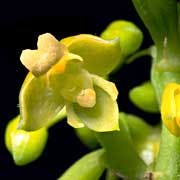
Polystachya (pol-ee-STAK-ee-a) A large genus of 150 epiphytic, lithophytic or occasionally terrestrial species that are basically African, with several species in tropical America and Madagascar. Hooker founded the genus in 1625, deriving the generic name from two Greek words meaning "many" and "ear of grain or spike" to denote the inflorescences in some species.
Ponera (poe-NER-a) There are seven epiphytic or lithophytic species in this genus ranging from Mexico to Central America, with one species found as far south as Ecuador. Lindley founded the genus in 1831, deriving the generic name from the Greek word "miserable" probably to denote the small habit and tiny flowers.
Ponerorchis (poe-ner-OR-kiss) This genus containing approximately 10 terrestrial species comes from Japan and Taiwan. H.G. Reichenbach described the genus in 1852, deriving the generic name from the Greek words meaning "miserable" and "orchid" to denote the small size of these orchids.
Ponthieva (pon-THEE-vah) A genus of 53 species of terrestrial American orchids related to Cranichis and distributed from the southern United States to Chile. Described in 1813 by Robert Brown, the name commemorates the French West Indian merchant Mr. Henri de Ponthieu, who collected plants in the Caribbean area and sent them to Sir Joseph Banks in 1778.
population (pop-yu-LAY-shun) The assemblage of progeny from a single mating or from a series of similar matings, particularly in the wild.
porosus, -a, -um (por-OH-sus) With small holes, pores or perforations; porose.
Porphyroglottis (por-feer-oh-GLOTT-is) A monotypic epiphytic genus native to Borneo and the lower Malay Peninsula. Ridley described the genus in 1896, deriving the generic name from two Greek words meaning "purple" and "tongue" to denote the lip of these flowers.
porrect (por-REKT) Directed outward and forward.
Porroglossum (por-roe-GLOSS-um) The 27 epiphytic or lithophytic species of this genus come from South America, ranging from Ecuador and Peru northward. Schlechter identified the genus in 1920, coining the generic name from two Greek words meaning "forward" and "tongue" to indicate the separation of the column from the lip.
posterior (poss-TEER-ee-or) Next or toward the main axis; the reverse of anterior.
pot (pot) A container, usually cylindrical and tapered, made of baked clay, plastic or other material, in which orchid plants are grown; to plant an orchid in such a container.
potshard: Broken terra cotta potshard.
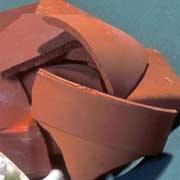
potshard (POT-shard) A piece or fragment of a broken earthen pot.
Potinara (poh-ti-NAR-ah) A hybrid genus, created in 1922, that was derived from Brassavola, Cattleya, Laelia and Sophronitis.
potting (pot-ing) The act of placing an orchid plant in a container and securing it in a medium for support and growth.
praecox (PREE-koks) Early blooming; very early; precocious.
praemorsus, -a, -um (pree-MOR-sus) Jagged, as if bitten off at the end.
praestans (PREE-stanz) Standing in front; excelling; distinguished.
prasinus, -a, -um (pray-SYE-nus) Grass-green.
precocious (pre-KOE-shus) Developing very early.
Prescottia (press-KOT-ee-ah) A genus of 35 species of terrestrial orchids distributed from Florida to Peru. It is related to Cranichis and was described in 1824 by Lindley in honor of the English botanist John D. Prescott, who collected plants in Russia and northern Asia.
prickle (PRIH-kl) A sharp outgrowth from the epidermis
primary (pri-MER-ee) The first part to develop.
primordium (pri-MOR-dee-um) The first recognizable histologically undifferentiated stage in the development of an organ.
primulinus, -a, -um (prim-yew-LYE-nus) Resembling a primrose.
princeps (PRIN-seps) Distinguished.
prismatocarpus, -a, -um (priz-mat-oh-KAR-pus) Having prism-shaped seed pods with three flat sides and three sharp angles.
proboscideus, -a, -um (proh-bos-SID-ee-us) Snout-like.
proboscis (proh-BAW-siss) The elongate feeding organ of an insect, formed of the mouth parts.
process (PRO-sess) An extension of any surface or part beyond the main outline.
procumbens (pro-KUM-benz) Prostrate; lying flat along the ground.
productus, -a,-um (proh-DUK-tus) Lengthened; extended or prolonged; produced.
proliferation (pro-lih-fer-AY-shun) Producing offshoots; growing by multiple division.
profusus, -a, -um (proh-FEW-sus) Abundant; profuse.
Promenaea (pro-men-EE-ah) A genus of 14 species of dwarf epiphytic orchids from Brazil and neighboring areas, related to Zygopetalum. It was described by Lindley in 1843, the name derived from Promeneia, a priestess at Dodona.
prophyllum (pro-FILL-um) The small bract at the base of a flower.
prostrate (PROS-trayt) Lying flat on the ground.
postular (poss-tewl-ar) Having blisterlike projections
protocorm (PROH-toh-korm) The first growth, a tuberlike body produced by a germinating orchid seed prior to the production of leaves, roots, etc.
protologue (PRO-toh-log) The information presented at the place and time of publication of a new taxon.
proximal (PROK-sim-al) The part nearest the axis.
pruinosus, -a,-um (prew-in-OH-sus) Covered with a whitish, frostlike bloom; excessively glaucous; pruinose.
pseudo- (SOO-doh) A Greek prefix meaning false.
pseudobulb (SOO-doh-bulb) A thickened portion of a stem, resembling a bulb but not being a true bulb, which is a modified stem composed of bulb scales.
pseudobulbous (SOO-doh-BUL-bus) Having or producing pseudobulbs.
pseudobulbless (SOO-doh-BULB-less) The condition of not having a noticeable pseudobulb.
pseudocopulation (SOO-doh-kop-yu-LAY-shun) A form of pollination in orchids wherein the flower mimics a female insect fooling the male enough to cause him to pollinate the flower.
Psychilis (sye-KYE-liss) The 15 epiphytic or lithophytic species of this genus are found in the West Indies. The genus was originally described by Rafinesque in 1838 and largely ignored until Sauleda resurrected it in 1988. The generic name was derived from two Greek words meaning "butterfly" and "lip" to denote the colorful lip.
Psychopsiella (sye-kop-SEE-ell-a) A monotypic epiphytic genus from Brazil and Venezuela. Lueck and Braem founded the genus in 1982, and used the diminutive form of Psychopsis, an allied group.
Psychopsis (sye-KOP-sis) A Neotropical genus of four species commonly called butterfly orchids. Previously maintained in Oncidium, they are remarkable for their dimorphic sepals and striking colors.
psycodes (sye-KOH-deez) Fragrant.
Psygmorchis (sig-MOR-kiss) A small genus of four or five twig epiphytes ranging from Central America south to Brazil and Bolivia. Dodson and Dressler founded the genus in 1972, deriving the generic name from two Greek words meaning "fan" and "orchid" to describe the plants' vegetative characteristics.
pterocarpus, -a, -um (tare-oh-KAR-pus) Having a winged fruit.
Pterostylis (tare-oh-STYE-liss) A genus of more than 100 species of terrestrial orchids from Australia, New Zealand, New Caledonia and New Guinea, it was described in 1810 by Robert Brown, who derived the name from the prominently winged column of the flower found in most species.
puberulent (pew-BEH-ru-lent) Finely pubescent.
pubescens (pew-BESS-enz) Downy; covered with fine short hair; pubescent.
pudicus, -a, -um (PEW-dik-us) Modest; bashful.
pugioniformis, -e (pew-ji-on-i-FORM-is) Dagger shaped.
pulchellus, -a, -um (pul-KEL-lus) Fair, pretty.
pulcher, pulchra, pulchrum (PUL-ker) Beautiful, lovely.
pullus, -a, -um (PULL-us) Dark colored.
pulvinatus, -a,-um (pull-vin-AY-tus) Formed like or resembling a cushion.
pumilus, -a, -um (PEW-mill-us) Dwarf, or low growing.
punctatus, -a, -um (punc-TAY-tus) Spotted; marked with dots, depressions or translucent glands; punctate.
pungent (pun-jent) Acid to the taste.
purpurascens (per-per-ASS-enz) Becoming or turning purple; purplish.
purpuratus, -a, -um (per-per-AY-tus) Marked with purple so as to have a certain regal quality.
purpureus, -a, -um (per-PER-ee-us) Purple.
purus, -a, -um (PUR-us) Spotless; of one color.
pusilla: Erycina pusilla is a very small plant.
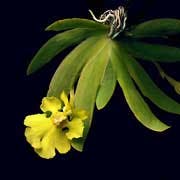
pusillus, -a, -um (pew-SILL-us) Very small.
pygmaeus, -a, -um (pig-MEE-us) Very small; pygmy.
pyramidalis, -e (peer-a-mid-DAY-liss) Pyramid shaped; pyramidal.
pyriformis, -e (peer-i-FOR-miss) Pear shaped; pyriform.
pyxidate (piks-UH-dayt) Having a lid.




